________________
198
EPIGRAPHIA INDICA.
[Vol. XXV.
22 Shashtim varsha-sahasrāņi mõdatē divi bhūmidaḥ [l*) akshēptā ch=ānumantā cha tâny=eva 23 narakē vasēd=iti pravarddhamāna-vijaya-rajya-samvatsarāḥ 80 7 Jyēshtha-divasa
300 (I*] 24 'Idam Vinayachandrāņa Bhanuchandrasya sūnună [l*) säsanam Rājasinhasya likhi tam sva-mukh=ājñayā [114*]
TRANSLATION (Lines 1-14) Om Hail! From the victorious (city of) Kalinganagara, which is pleasant in all seasons, the glorious Mahārāja Indravarman ........ addresses the following) order to all the householders en masse at the village of Haribhața in the district of) Kröshțukavarttani:
"Be it known to you that we have granted, after portioning it off, and on being informed by Talavaradēva, the Bhögika,' and for increasing the religious merit of (Our) parents and of Ourselves, two halas of land in this village for the sake of performing (rites known as) bali, charu and sattra, and for the repairs of dilapidations (of the temple) of god Rämēsvara-bhattāraka (situated in the village called) Dantayavāgū and (in addition to that) another hala of land in the same) Dantayavāgū, having constituted it as an agrahāra for god (Rāmēsvara-bhattāraka) which is to last as long as the moon and the sun, and having exempted it from all impositions.
Having known this, nobody should cause any hindrance".
(LI. 15-18) The boundary marks of the land (granted) in (the village of) Haribhata are as follows On the north, the storm water channel of the tank (called) Kshatriya-tațāka; on the east, an arjuna tree, after that a row of ant-hills, then up to the artificial line of heaped-up stones, then a nimba tree; on the south, the same channel of that tank (Kshatriya-tatāka): on the west, a well, then the twin arjuna trees, then the royal road.
(Ll. 18-23) The future kings should maintain this religious gift. And likewise the verses sung by Vyāsa are quoted :
(Here come three of the customary verses.) (Ll. 23-24) The year 87 of the prosperous victorious reign; (the month) Jyēshtha, the day 30.
This edict (sāsana) of Rājasimha has been written at the command of his (the king's) own mouth, by Vinayachandra, the son of Bhānuchandra.
1 Read aset (||3*] iti.
* Mr. Jagadev reads the symbol as 10. Metre: Slöka (Anushfubk).
Read sinhasya. . For a translation of the long string of epithets that follows see above, Vol. III, p. 129.
• Taravard as an official title (Mahapratīhāra-Taravara-Vinayaśārasya) occurs on a Basarh seal (An. Rep., A. 8. 1., 1903-4, p. 109, No. 16). Mahatalavara (along with its feminine Mahitalavari) in the sense of a high dignitary with indefinite function is frequently mentioned in inscriptions of Ikshvāku kings from Nagarjunikonda (above, Vol. XX, pp. 6-7 and f. n. 1).
In the present instance also Talavaradeva-Bhögika (or Talavara-dēvabhögika 1) seems to have been used as the title of an officer who did the dual function of a talavara and a bhögika.
For the explanation of the term Bhögika, see above, Vol. XXIII, pp. 59 and 64. Also C. 1. 1., Vol. III, p. 100, n. 1.
In explaining the technical word kula, in Manu, VII, 119, Kulluka observes thus: shadgavath madhyamaria halam=iti tathavidha-haladvayena yavati bhumir dhyatë tatakulam=iti wadati. Here the connotation of hala is mut elear. In any case, hala appears to be a recognised kind of land measure.
I am grateful to my revered teacher Dr. R. G. Basak, M.A., Ph.D., Senior Professor of Sanskrit, Presi. dency College, Calcutta, for kindly suggesting a number of corrections in my interpretation of the text of the inscription.




